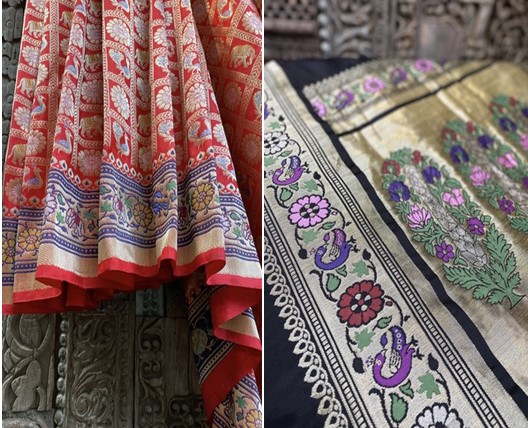The designer duo behind Shyamal & Bhumika tell Vogue about the rich Amdavadi zari sari, how the technique evolved over the years and how are they keeping it alive with roots all the way back in the 1600s, the Amdavadi zari sari is well known not only for its timeless elegance but also the intricate detailing that goes into producing the drape. Vogue spoke to designers Shyamal and Bhumika Shodhan about keeping the ancient craft of weaving the Amdavadi zari sari alive, its evolution through the decades, and their own attempt to make this technique relevant in the 21st century.
What are the origins of the Amdavadi weaving technique?
The Amdavadi or Ashavali sari weaving technique dates back to almost 600 years . In the pre-Ahmad Shah Durrani era, the artisans of Ashapal, now known as Ahmedabad, used to weave this gorgeous silk textile in zari and incorporate beautiful motifs. The zari saris and textiles are woven using the traditional jacquard loom. The layout of the sari and motifs are designed on graph paper by an artist and this is then prepared on hundreds of perforated cards that are punched and attached to the loom. The threads are woven on pit looms, on which the warp and weft are carefully interwoven by moving the shuttle back and forth. This is a meticulous process because the motifs are also incorporated during this process. Meanwhile, the borders are usually adorned with minakari (enamelling) in flora and fauna designs that are woven on different types of silks with real zari or silk threads. The process involved in a single sari takes nearly a month to finish.

What are the most common motifs used in Amdavadi zari sari?
The motifs of the Amdavadi Saris are inspired by the architecture and the flora and fauna of the region. Mor popat, popat vel, ganga jamuma, lagdi patta are some unique designs used in weaving the borders. The pallu has the traditional twill gold weave, ganga jamuna checks and colourful meenakaari motifs set within it. The body of the sari features an all-over jaal design or motifs. Some of the unusual designs seen in this textile are the janglo, kaju phool, bor jaal, mor jaal, uref bel, sikka butti and chaand taara. Women who wore these saris, traditionally covered their heads and draped it with a seedha palla. Some of these saris had a unique feature of a thaal motif woven into the portion that covered the head. Each sari or dupatta has a corner motif called a konia that is incorporated at the corner of the pallu.
How have you revived the sari?
To begin with, we tried to understand why it went out of fashion in the first place. One of the reasons was the weight, as they used thicker silk that could be passed down to generations. This also affected the way the sari was draped. So, we suggested the weavers to make the fabric softer, while preserving the integrity of the sari. When we started working on Amdavadi zari, Bhumika sourced the original saris, that were decades old, from our family and friends to study the motifs and we recreated those on a special jacquard loom. Apart from these, we also get exclusive zari threads, custom made for us in Surat. These threads are very similar to the ones used in the original saris from the early 1900s. The Shyamal & Bhumika Amdavadi sari infused all of its old-world charm while being lighter and more wearable.
What inspired you to take up the revival of the Amdavadi zari sari?
Around the time Bhumika was finalising her graduation project at the National Institute of Fashion Technology, she chanced upon an heirloom sari in her grandmother’s wardrobe and she was mesmerised. The sari had an intricate weaving pattern, beautiful motifs and an extraordinary sheen born from the real zari that was used in it. She couldn’t figure why something so beautiful was dying a slow death and she set out to restore its lost charm. The demand for the zari weaving technique increased tremendously after our first couture line.



















Your Message